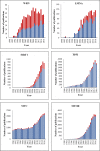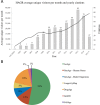Human Ageing Genomic Resources: new and updated databases
- PMID: 29121237
- PMCID: PMC5753192
- DOI: 10.1093/nar/gkx1042
Human Ageing Genomic Resources: new and updated databases
Abstract
In spite of a growing body of research and data, human ageing remains a poorly understood process. Over 10 years ago we developed the Human Ageing Genomic Resources (HAGR), a collection of databases and tools for studying the biology and genetics of ageing. Here, we present HAGR's main functionalities, highlighting new additions and improvements. HAGR consists of six core databases: (i) the GenAge database of ageing-related genes, in turn composed of a dataset of >300 human ageing-related genes and a dataset with >2000 genes associated with ageing or longevity in model organisms; (ii) the AnAge database of animal ageing and longevity, featuring >4000 species; (iii) the GenDR database with >200 genes associated with the life-extending effects of dietary restriction; (iv) the LongevityMap database of human genetic association studies of longevity with >500 entries; (v) the DrugAge database with >400 ageing or longevity-associated drugs or compounds; (vi) the CellAge database with >200 genes associated with cell senescence. All our databases are manually curated by experts and regularly updated to ensure a high quality data. Cross-links across our databases and to external resources help researchers locate and integrate relevant information. HAGR is freely available online (http://genomics.senescence.info/).
© The Author(s) 2017. Published by Oxford University Press on behalf of Nucleic Acids Research.
Figures


References
-
- Goto M. Hierarchical deterioration of body systems in Werner's syndrome: implications for normal ageing. Mech. Ageing Dev. 1997; 98:239–254. - PubMed
Publication types
MeSH terms
LinkOut - more resources
Full Text Sources
Other Literature Sources
Medical

